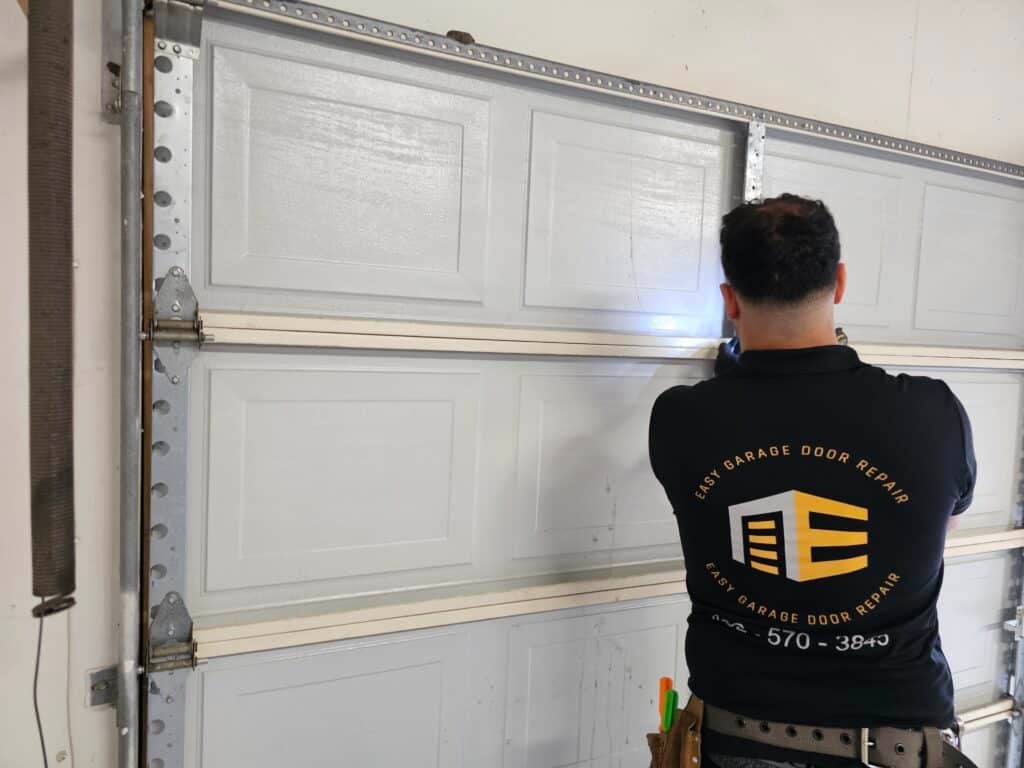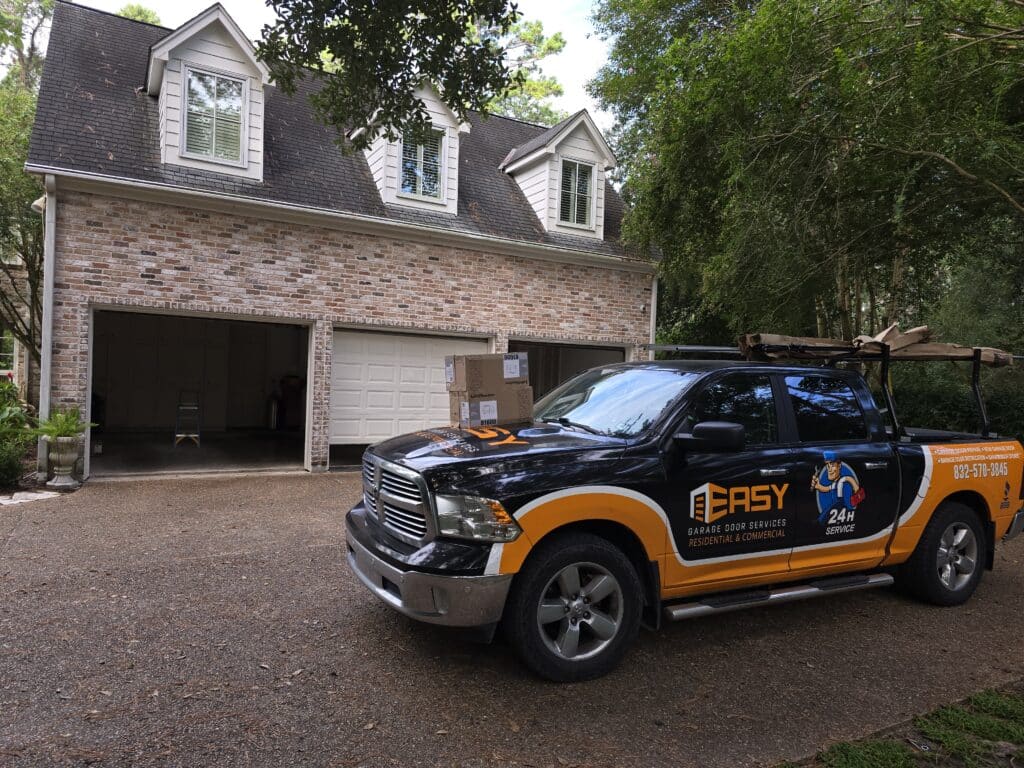Living in Houston means enjoying warm weather, great food, and friendly neighbors. But it also means preparing for hurricane season every year. Your garage door—often the largest opening in your home—can be your biggest vulnerability when those Gulf storms come calling.
After seeing what happened during recent storms, many Houston homeowners are taking garage protection more seriously. And for good reason! A compromised garage door can lead to catastrophic damage throughout your entire home.
Let’s walk through practical steps to protect your garage (and by extension, your whole house) from hurricane damage, without breaking the bank or needing an engineering degree.

What Makes a Garage Door Hurricane-Proof?
Hurricane-proof garage doors are built to handle strong winds and flying debris during severe storms. Made of reinforced steel or aluminum, they include extra bracing, like horizontal and vertical supports, to prevent bending. These doors meet strict wind-load standards, withstand winds of 150-200 mph, and resist impacts from debris. They feature reinforced tracks, heavy-duty rollers, stronger springs, and secure multi-point locking systems. Enhanced weatherstripping and sealed joints keep water out, and they are installed with special brackets anchored to reinforced concrete foundations to distribute wind pressure evenly.
Why Garage Protection from Storms is Important in Houston
Your garage door might seem sturdy during normal weather, but hurricane-force winds create pressure that can cause even newer doors to fail. When wind enters through a damaged garage door, it creates an internal pressure that can push your roof off your house.
For Houston residents, flooding presents another major concern. Most garages sit at ground level, making them prime targets for water intrusion. Depending on your location, you might face different risks:
- Coastal areas (Clear Lake, Seabrook): Higher wind speeds and storm surge
- Bayou-adjacent neighborhoods (Meyerland, Kingwood): Flash flooding risks
- Inland areas (Spring, Katy): Still vulnerable to 100+ mph winds
Local building codes require garage doors to withstand specific wind loads based on your ZIP code, typically between 110-150 mph in the greater Houston area. But many older homes have doors that don’t meet current standards.r ZIP code, typically between 110-150 mph in the greater Houston area. But many older homes have doors that don’t meet current standards.
Know Your Local Code Requirements
Houston-area homes must meet specific windstorm requirements, especially if you’re installing a new garage door. The Texas Department of Insurance (TDI) provides guidelines for windstorm-certified products that can withstand our Gulf Coast weather.
If you’re in Harris County, your garage door should withstand at least 110 mph winds, with coastal areas requiring higher ratings (up to 150 mph). These aren’t just suggestions—they’re requirements that protect your home and potentially lower your insurance costs.
How to Hurricane-Proof Your Garage: Replace or Retrofit Your Garage Door?
Before diving into specific solutions, you need to decide whether to replace your door entirely or retrofit your existing one:
Consider replacement if:
- Your door is wooden or made of lightweight aluminum
- It’s a single-panel door (swings out as one piece)
- It’s more than 15 years old
- It shows signs of rust, warping, or damage
Retrofitting might work if:
- You have a sectional steel door in good condition
- Your door was made after 2000
- You’re on a tight budget
- Your door tracks and hardware are in good shape
Install Wind-Rated Garage Doors
A wind-rated garage door is your best defense against hurricane damage. These doors:
- Feature reinforced panels and stronger hardware
- Include pressure ratings (look for doors rated for your area’s wind speed)
- Often has impact resistance for flying debris
Use a Garage Door Bracing Kit
If replacement isn’t in your budget, a bracing kit can significantly strengthen your existing door. These kits typically cost between $150-300 and include:
- Vertical steel posts that brace against the floor and ceiling
- Mounting hardware to secure the posts to your door
- Quick-installation features for storm preparation
Most bracing systems can be installed when a storm is approaching and removed afterward. Some homeowners install the mounting hardware permanently and only add the braces when needed.
While you can install some bracing kits yourself, getting professional help ensures proper anchoring to concrete floors and ceiling joists, critical for the system to work correctly.

Strengthen Door Tracks and Hardware
Your garage door is only as strong as its weakest component. Upgrading these elements adds significant strength:
- Replace standard tracks with 14-gauge or heavier steel tracks
- Install additional brackets to secure the tracks to the wall studs (not just drywall)
- Upgrade to heavy-duty rollers with steel ball bearings
- Replace standard hinges with hurricane-rated versions
Make sure all hardware is secured into structural elements like wall studs or concrete block, not just the garage’s drywall or siding.
Seal Openings to Prevent Flood Damage
Even with a reinforced door, water can still seep in during heavy rain. Add these protections:
- Install new bottom seals and weatherstripping around the entire door
- Consider a threshold seal that creates a dam-like barrier at the garage entrance
- For flood-prone areas, keep water barriers like sandbags or quick-dam barriers on hand
- Install drainage systems like French drains or a sump pump if your garage sits below grade
A properly sealed garage door can keep out wind-driven rain and minor flooding, potentially saving thousands in water damage repairs.
Protect Garage Windows
If your garage has windows, don’t forget to protect them too:
- Install permanent hurricane shutters or impact-resistant glass
- Keep pre-cut plywood panels ready for emergency installation
- Consider removable storm panels that store flat when not needed
For budget protection, pre-cut plywood to fit each window, label them, and drill mounting holes in advance so you can quickly install them before a storm.

Anchor Interior Contents
During a hurricane, unsecured items in your garage can become dangerous projectiles:
- Bolt shelving units to the wall studs
- Secure large items like refrigerators or freezers
- Store chemicals and hazardous materials in waterproof containers
- Raise valuable items at least 12 inches off the floor to protect them from minor flooding
Consider installing ceiling-mounted storage racks to keep seasonal items and emergency supplies safely elevated.
Install Manual Locks and Battery Backups
Power outages are almost guaranteed during hurricanes, so prepare your garage door accordingly:
- Make sure you know how to manually open your garage door (and that the release cord works)
- Install a battery backup for your garage door opener
- Add manual slide locks for additional security and wind resistance
- Keep the manual release key accessible but secure
What to Do Before a Storm Hits
When a hurricane is approaching, follow this quick checklist:
- Remove items stored near the garage door
- Place sandbags along the door threshold if flooding is expected
- Install your bracing system if you use one
- Unplug the garage door opener to prevent electrical damage
- Lock any manual locks or bolts
- Park cars elsewhere if possible (or at least away from the door)
- Take photos of your preparations for insurance purposes
Maintenance Tips for Hurricane Season
Regular maintenance keeps your hurricane protections ready when needed:
- Inspect door tracks, rollers, and springs every six months
- Test your manual release mechanism quarterly
- Check and replace weatherstripping annually
- Lubricate moving parts before hurricane season begins
- Test your battery backup system monthly during hurricane season
Cost Breakdown for Hurricane-Proofing Your Garage
| Item | Estimated Cost (Houston) |
| Wind-rated garage door | $900 – $2,000+ |
| Professional installation | $200 – $500 |
| Bracing kit | $150 – $300 |
| Flood barrier or threshold seal | $50 – $150 |
| Track reinforcement | $100 – $200 |
| Battery backup system | $125 – $250 |
If budget is a concern, start with the most critical improvements first:
- Door bracing or reinforcement
- Sealing and weatherstripping
- Hardware upgrades
- Flood protection
Insurance Savings and Documentation
Many insurance companies offer discounts for hurricane mitigation efforts. To maximize potential savings:
- Take before and after photos of all improvements
- Keep receipts for materials and professional installation
- Ask your insurance agent about specific discounts for garage door reinforcement
- Consider getting a wind mitigation inspection (typically $75-150) that may qualify you for premium reductions
Some Houston homeowners report saving 5-15% on their insurance premiums after documenting garage door improvements.
When to Call a Professional
While some hurricane-proofing steps are DIY-friendly, others require professional help:
- Full door replacement should be done by certified installers
- Bracing systems need proper anchoring to structural elements
- Electrical work for backup systems requires proper knowledge
- Code compliance often requires professional installation with permits

Signs you should call a pro immediately:
- Your door is significantly misaligned
- You notice bent tracks or damaged panels
- The door won’t open or close properly
- You hear unusual noises during the operation
Easy Garage Door Repair is the right place you need to call. Locally owned, our company is well-familiar with Houston’s weather challenges and has skilled experts who handle the entire process, from inspection to installation with care and precision. Call us at (832) 979-6648, and we will hurricane-proof your garage in Houston properly.








